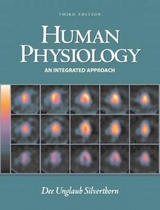
Human Physiology
Pearson (Verlag)
978-0-13-017697-4 (ISBN)
- Titel erscheint in neuer Auflage
- Artikel merken
The unique integrated approach in Human Physiology: An Integrated Approach, Second Edition helps readers see the "big picture." SilverthornÕs problem-solving focus develops readersÕ skills by helping them connect facts and concepts and apply them to real-world situations. Readers receive a more meaningful and longer lasting knowledge of physiology as they participate in SilverthornÕs active learning approach.
DEE UNGLAUB SILVERTHORN studied biology as an undergraduate at Tulane University and went on to earn a Ph.D. in marine science at the University of South Carolina. Her research interests center on comparative invertebrate physiology; however, she began her teaching career in the Physiology Department at the Medical University of South Carolina. Drawing on her training in both comparative and traditional human physiology, Dee has taught a wide range of students, from those in medical school and college to those still preparing for a higher education. At the University of Texas she lectures in physiology, coordinates undergraduate laboratories in physiology, and instructs graduate students in a course on developing teaching skills in the life sciences. She has substantial experience with active learning in the classroom, and has given workshops on this subject at regional, national, and international conferences. Dee is a member of the American Physiological Society and an associate editor of Advances in Physiology Education. She works with members of the International Union of Physiological Sciences to improve physiology education in developing countries. She is also a member of the Human Anatomy and Physiology Society, the Society for Biology Laboratory Education, the Society for College Science Teaching, the American Association for the Advancement of Science, and Sigma Xi. Her free time is spent creating multimedia fiber art and enjoying the Texas hill country with her husband, Andy, three dogs, and a cat.
I. BASIC CELL PROCESSES: INTEGRATION AND COORDINATION.
1. Introduction to Physiology.
Levels of Organization. Physiology Is an Integrative Science. Function and Process. The Evolution of Physiological Systems. Homeostasis. Themes in Physiology. The Science of Physiology.
2. Atoms, Ions, and Molecules.
Elements and Atoms. Molecules and Bonds. Solutions and Solutes. Biomolecules.
3. Cells and Tissues.
Studying Cells and Tissues. Cellular Anatomy. Tissues of the Body. Tissue Remodeling. Organs.
4. Cellular Metabolism.
Energy in Biological Systems. Chemical Reactions. Enzymes. Metabolism. ATP Production. Synthetic Pathways.
5. Membrane Dynamics.
Membranes in the Body. Cell Membranes. Body Fluid Compartments. Movement across Membranes. The Distribution of Water and Solutes in the Body. Integrated Membrane Processes: Insulin Secretion.
II. HOMEOSTASIS AND CONTROL.
6. Communication, Integration, and Homeostasis.
Cell-to-Cell Communication. Signal Pathways. Modulation of Signal Pathways. Homeostasis. Control Pathways: Response and Feedback Loops.
7. Introduction to the Endocrine System.
Hormones. The Classification of Hormones. Control of Hormone Release. Endocrine Pathologies. Hormone Evolution.
8. The Nervous System.
Organization of the Nervous System. Cells of the Nervous System. Electrical Signals in Neurons. Cell-to-Cell Communication in the Nervous System. Integration of Neural Information Transfer.
9. The Central Nervous System.
Evolution of Nervous Systems. Anatomy of the Central Nervous System. The Spinal Cord. The Brain. Brain Function.
10. Sensory Physiology.
General Properties of Sensory Systems. Somatic Senses. Chemoreception: Smell and Taste. The Ear: Hearing. The Ear: Equilibrium. The Eye: Vision.
11. Efferent Peripheral Nervous System: The Autonomic and Somatic Motor Divisions.
The Autonomic Division. The Somatic Motor Division.
12. Muscles.
Skeletal Muscle. Mechanics of Body Movement. Smooth Muscle. Cardiac Muscle.
13. Integrative Physiology I: Control of Body Movement.
Nervous Reflexes. Autonomic Reflexes. Skeletal Muscle Reflexes. The Integrated Control of Body Movement. Control of Movement in Visceral Muscles.
III. INTEGRATION OF FUNCTION.
14. Cardiovascular Physiology.
Overview of the Cardiovascular System. Pressure, Volume, Flow, and Resistance. Cardiac Muscle and the Heart. The Heart as a Pump.
15. Blood Flow and the Control of Blood Pressure.
The Blood Vessels. Blood Pressure. Resistance in the Arterioles. Distribution of Blood to the Tissues. Exchange at the Capillaries. The Lymphatic System. Regulation of Blood Pressure. Cardiovascular Disease.
16. Blood.
Plasma and the Cellular Elements of Blood. Blood Cell Production. Red Blood Cells. Platelets and Coagulation.
17. Respiratory Physiology.
The Respiratory System. Gas Laws. Ventilation. Gas Exchange in the Lungs. Gas Exchange in the Tissues. Gas Transport in the Blood. Regulation of Ventilation.
18. The Kidneys.
Functions of the Kidneys. Anatomy of the Urinary System. Overview of Kidney Function. Filtration. Reabsorption. Secretion. Excretion. Micturition.
19. Integrative Physiology II: Fluid and Electrolyte Balance.
Fluid and Electrolyte Homeostasis. Water Balance and the Regulation of Urine Concentration. Sodium Balance and the Regulation of ECF Volume. Potassium Balance. Behavioral Mechanisms in Salt and Water. Integrated Control of Volume and Osmolarity. Acid-Base Balance.
IV. METABOLISM, GROWTH AND AGING.
20. Digestion.
Function and Processes of the Digestive System. Anatomy of the Digestive System. Secretion. Digestion and Absorption. Regulation of GI Function. Integration of GI Function. Immune Functions of the GI Tract.
21. Energy Balance, Metabolism, and Growth.
= Energy Balance and Metabolism.
Energy Balance. Metabolism. Anabolic Metabolism Dominates in the Fed State.
Homeostatic Control of Metabolism.
Pancreatic Hormones. Neurally Mediated Aspect of Metabolism.
Long-Term Endocrine Control of Metabolism.
Adrenal Glucocorticoids. Thyroid Hormones.
Endocrine Control of Growth.
Growth Hormone. Tissue and Bone Growth. Calcium Balance.
22. The Immune System.
Overview of Immune System Function. Pathogens of the Human Body. The Immune Response. Anatomy of the Immune System. Innate Immunity. Acquired Immunity. Immune Response Pathways. Neuro-Endocrine-Immune Interactions.
23. Integrative Physiology III: Exercise.
Metabolism and Exercise. Ventilatory Responses to Exercise. Cardiovascular Responses to Exercise. Feedforward Responses to Exercise. Temperature Regulation. Exercise and Health.
24. Reproduction and Development.
Sex Determination. Basic Patterns of Reproduction. Male Reproduction. Female Reproduction. Procreation. Pregnancy and Parturition. Growth and Aging.
Appendix A: Physics and Math.
Appendix B: Genetics.
Appendix C: Anatomical Positions of the Body.
Appendix D: Answers to Concept Checks, Graph/Figure Questions, and End-of-Chapter Level 4 Questions.
Glossary/Index.
Photo Credits.
| Erscheint lt. Verlag | 25.8.2000 |
|---|---|
| Sprache | englisch |
| Maße | 220 x 284 mm |
| Gewicht | 1900 g |
| Themenwelt | Studium ► 1. Studienabschnitt (Vorklinik) ► Physiologie |
| ISBN-10 | 0-13-017697-4 / 0130176974 |
| ISBN-13 | 978-0-13-017697-4 / 9780130176974 |
| Zustand | Neuware |
| Haben Sie eine Frage zum Produkt? |
aus dem Bereich



